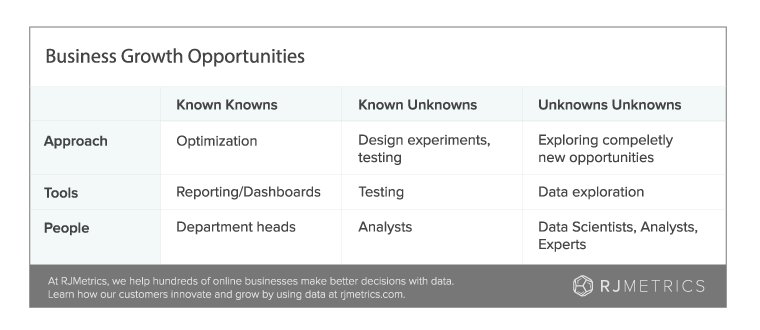Starting a business is like being Jon Snow: you know nothing. Your product, brand, and marketing channels are all completely unknown, and your task is just to try stuff. Start collecting data points and try not to run out of money in the process.
As you start to collect some initial data, you get more comfortable. Knowledge is power, or in this case, the ability to sleep at night. But there are still so many things you know you don’t know. “How much better could this be if…?” Many businesses are so fixated on finding answers for the “Known Unknowns” (you know the question but you don’t know the answer) that they fail to think about the Unknown Unknowns (you don’t even know the question).
In business, finding the answers to the obvious questions is table stakes: you must do it to even play the game. But what separates the good from the great businesses is their ability to dive deep into the world of Unknown Unknowns and come back with pearls.
In this post, we’ll explore how to use data to get you there.
Three Ways to Grow Your Business
Adopting the Rumsfeldian mindset, there are three primary kinds of growth opportunities that should be driving your business:

As most businesses grow, the pool of Known Knowns will grow. And due to the inherent human tendency towards loss aversion, your tolerance for exploring the unknown will shrink.
Exploring the unknown requires trying new things, and trying new things is inherently risky. Did you have heartburn the last time you made a significant change to your pricing? How about when you launched a completely new home page? It’s natural—businesses are just people, after all.
But your business will shrivel up and die without a constant stream of insights flowing into it. In a healthy business these opportunities create a pipeline. The pool of Known Knowns is always growing, directly translating into revenue, as new information is being added from the Known Unknowns and the Unknown Unknowns.

What are the Unknown Unknowns
Unknown Unknowns are big. They are big opportunities that fall far outside of the day-to-day of your business. These include things like:
- Market segments you haven’t discovered yet
- Features that people adore
- Product innovations
- The “why?” behind customer behaviors
These are tough questions to answer, and plenty of businesses are willing to settle for trying to answer them with a best guess. Don’t do this. Tackling the Unknown Unknowns is the future of your business.
The progression of Unknown Unknowns
While the Unknown Unknowns are different for every business, there are common “categories” of Unknown Unknowns that every growing business will face as they grow.
Start-ups
- Unrecognized Assumptions: Start-ups are often grown on hard work and passion. This level of intensity tends to lead to many assumptions going unnoticed and unstated. These assumptions create giant blind spots in thinking about the business.
- Early Adopters: It’s tough to tell at the beginner if your early adopters are representative of a market segment worth betting on, or just a few curious eyes you happened to attract. In the excitement of acquiring the first handful of users, this tends to be a question founders never ask.
Growth Phase
- New Market Segments: In the effort to serve the customers you have exceptionally well, it’s easy to miss additional market segments. Focus on your core demographic is really good, but if a tweak or two makes your product appealing to a brand new market — go for it.
- Long-term Viability: No founder wants to admit that their product or service might just be a fad too. This belief, however, is hardly enough to make it true. Most start-ups fail. Smart founders should always be looking for trends in their data that show signs of a sustainable business or short-term buzz only.
Established
- New Things: It’s at this stage that management develops a tendency to over-focus on what has worked in the past. It feels safe. It also sets you up to miss new features, product lines, or business models that could take your business to the next phase of growth.
Using your data to find the Unknown Unknowns
Even though these are Unknown Unknowns, you’re still not flying blind. Very often, your data will hold clues that can point you to the unseen drivers that are impacting your business.
Here are four tried and true tips for using data to find the things you don’t know you don’t know:
1. Analyzing something you don’t regularly analyze
Recently I was working with a SaaS company that was making an extremely reasonable assumption — they assumed that the more people used their product, the more likely they would be to keep using it. Because of this assumption, their onboarding process focused on getting new customers to use the product as soon as possible.
When we analyzed product usage data and correlated it to long-term customer engagement and churn, we realized this assumption was dead wrong. Long-term subscribers were often quite slow to start using the product. They spent more time up front familiarizing themselves with the in’s and out’s of the service, and what they were learning during this time contributed to a better experience down the road.
Based on this finding the company completely restructured their onboarding, replacing action-focused messaging with more educational content.
This correlation was completely new analysis for them. Some other things you could look for include things like:
- Looking at web flow patterns without an agenda
- Profiling the customers who are repeating with you vs. not repeating
- Conducting merchandising analysis looking for things like: what converts well, what leads to a second purchase
2. Analyzing something old in a new way
I did some work in the past with an ecommerce company that sells health products. The time leading up to the New Year is critical for them as people prepare for the New Year’s Resolutions. Traditionally, they had always paid an enormous amount of attention to the week between Christmas and the New Year, focusing on optimizing each day leading up the new year.
When they switched this analysis to look at day of the week (i.e., Monday, Tuesday) vs. day until the new year (i.e., 5 days, 4 days), they saw a whole new opportunity. They had been treating every day the same, but found that ROI on ad spend was actually quite a bit higher on weekends than on weekdays. They were able to adjust media spend and improve ROI just by analyzing their data slightly different than the way they were used to.
Some other ways you can look at the same data in a new way include:
- Analyzing your media spend in terms of long-term customer value
- Running statistical correlations on customer or product properties and Lifetime Value
3. Analyzing something on a deeper level
One of our clients does a large chunk of their business via mobile devices and tablets. They knew this was an important channel for them and were investing a significant amount of money in delivering a smooth experience regardless of device. Until recently, they were only looking at customer behavior at the app or browser level. Then they went deeper.
What they found is that customers behave very differently based, not just on app or browser interactions, but also based on the device. Meaning that an Android app user was behaving surprisingly different than an iOS app user, even though they were both on mobile devices.
This data helped them in a few key ways: First, they started looking for ways to boost the lowest converting combinations. Second, they reallocated media spend to drive traffic to the top converters. This allowed them to maintain marketing ROI while the product caught up to user needs.
Some other ways you can go deeper with your data include:
- Producing data for an area or tactic you typically analyze, but then asking a colleague to draw conclusions
- Looked at your favorite metrics (i.e., revenue by channel, email campaign performance) and adding an additional level of segmentation
4. Getting additional information
In all of these examples we’ve been looking at quantitative analysis, but another great way to start identifying Unknown Unknowns includes qualitative research. One of the things that we’ve been talking about here at RJMetrics the “pockets” where prospects are interacting and learning about business intelligence long before they find us.
There are a myriad of conversations and recommendations happening offline that are difficult to track or measure. We have very little understanding of how these prior influences shape acquisition, the buying cycle, or long-term customer engagement. This is something that is has only very recently for us, moved from an Unknown Unknown to a Known Unknown.
Some ways to gather these kinds of qualitative insights on what you might be missing include:
- Asking what others working on similar programs or products are doing to grow their business
- Asking customers what products or services they are spending their money on
- Asking customers whether they’ve referred someone and why or why not
Go exploring
Venturing into the murky world of the Unknown Unknowns is scary business. For most business leaders, it’s an uncomfortable experience admitting that you don’t know. But it’s also a world that’s rich with opportunities. And remember, if you need help — you know where to find us.
